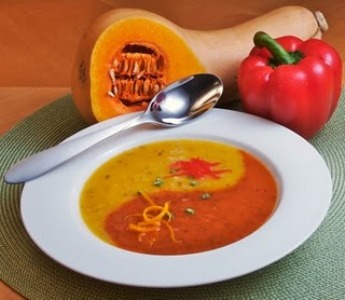Ying and Yang in Vietnam cuisine
The yin-yang represents the two extreme points of things. This dichotomy is mutually and simutaneously contradictory and complementary, like black and white, light and darkness, solid and tender, cold and hot, etc. In this concept, yin symbolizes the group of those that like liquid, humid, cold, passive, interior, sky, moon, night, water, winter. On the other hand, yang represents those that of solid, hot, active, exterior, earth, sun, fire, summer, and so on. The point is to bring the balance of the hyphen to things naturally. The aim is to reach the universal equilibrium for those naturally created things.

Vietnamese cooking culture is infused by the concept of yin-yang integrating with the five elements those which have been originated since Văn Lang civilization. Vietnamese cuisine therefore is generated its detailed preparation in according to this yin-yang concept.
Vietnamese food is distinguished in according to the grouping of dishes which are in relation to the five elements of yin-yang: cold – water (hàn), hot – fire (nhiệt), warm – wood (ôn hòa), fresh – metal (lương), temperate – earth (bình). It is taken into account the compensation, interaction and combination of ingredients and condiments in the design of a dish. The note is taken on a series of vegetables and condiments in creating Vietnamese food recipes.
For instance, in the case of ginger (gừng), known for curing sicknesses caused by the "cold" (cough, flu), the condiment of the yang characteristics, is widely used in all the dishes having tendency to bear the cold: bí đao (marrow quash), cải bắp (cabbage), rau cải (lettuce) and cá (fish). Furthermore, hot pepper is of yang nature (hot) and frequently used in dishes having cold, temperate characteristics like seafood, steamed fish for example. One used to eat fermented chicken's or duck's eggs (trứng gà lộn, trứng vịt lộn) having the yin characteristics along with a very flavorful leaf (rau răm) of the yang tendency. The yin bearing watermelon is always eaten with the yang of natured salt.
Vietnamese cuisine is sometimes used as an effective medicine to cure dysfunctions caused by the loss of yin-yang balance in the human body. For the Vietnamese, the scenario seen in nature is also found inside their bodies. When an organ becomes too yin, it leads to a slowdown in physical metabolism like feeling cold, slow heartbeats, indigestion, etc... On the other hand, if it becomes too yang, it triggers an acceleration of physical metabolism like feeling hot, fast heartbeats, physical and mental hyperactivity, and so on.
Vietnamese dish remains the fish sauce. In the preparation of this national sauce, it is noticed there are 5 flavors classified according to the 5 element of yin-yang: salty (mặn) with the fish sauce (nước mắm), bitter (đắng) with the zest of lemon (vỏ chanh), sour (chua) with the juice of lemmon (or vinegar), hot (cay) with powdered or crushed hot pepper, and sweet (ngọt) with powdered sugar. Those five flavors (mặn, đắng, chua, cay, ngọt) combined and found in the national sauce of Vietnamese people correspond respectively to five elements defined in yin-yang concept: water, fire, wood, metal, earth (thủy, hỏa, mộc, kim, thổ).










